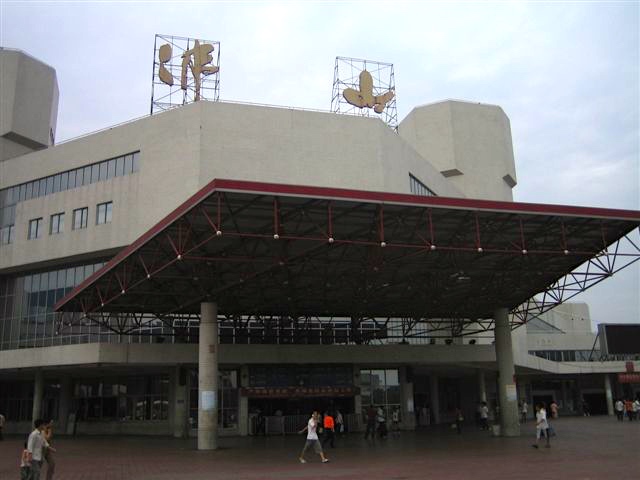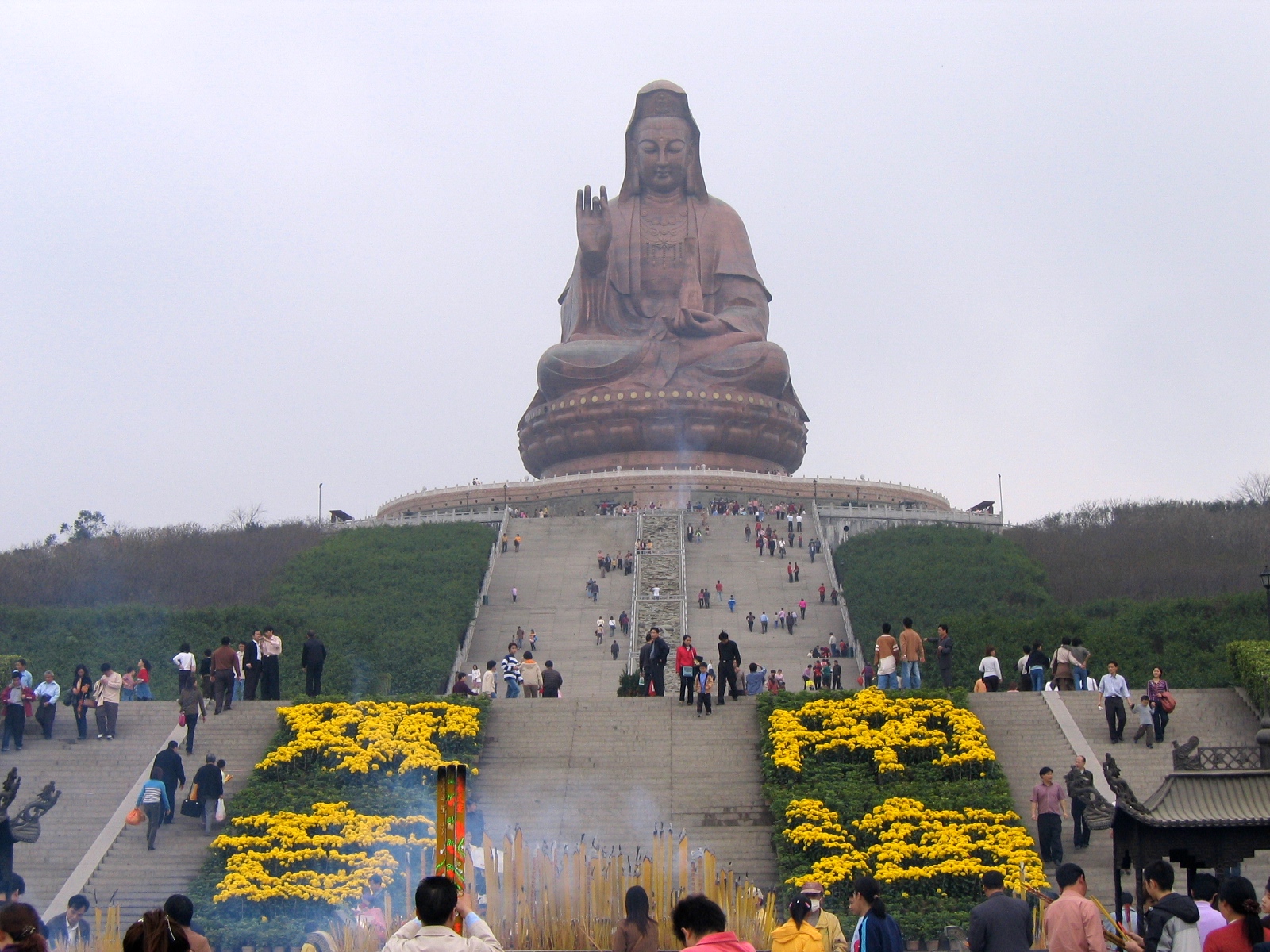|
Gaoming
Gaoming is an urban district of Foshan, Guangdong, China. Gaoming is located west of downtown Foshan and had a population of 469,038 during the 2020 census. It covers an area of . History There were inhabitants settled in the region around four thousand years. Under the Qing, Gaoming County was administered as part of the commandery of Zhaoqing. Administration divisions Gaoming District is located within Foshan of Pearl River Delta region. Neighboring county-level cities, districts, and counties are Gaoyao to the North, Xinxing County to the West, Heshan to the South, Nanhai District and Sanshui District to the East, respectively. The district is divided into one subdistrict and three towns. Economy Gaoming has resources of Gold, Copper, Tungsten and other minerals. Gaoming county is an important producer of foodstuffs within Guangdong, as well as food and textiles. McDonald's and KFC both feature along Wenchang Rd. alongside other Western clothes retail outlets and ... [...More Info...] [...Related Items...] OR: [Wikipedia] [Google] [Baidu] |
Pearl River Delta Region
The Pearl River Delta Metropolitan Region is the low-lying area surrounding the Pearl River estuary, where the Pearl River flows into the South China Sea. Referred to as the Guangdong–Hong Kong–Macao Greater Bay Area in official documents, the region is one of the most densely populated and urbanized regions in the world, and is considered a megacity by numerous scholars. It is currently the wealthiest region in Southern China and one of the wealthiest regions in China along with the Yangtze River Delta in Eastern China and Jingjinji in Northern China. Most of the region is part of the Pearl River Delta Economic Zone, which is a special economic zone of China. The region is a megalopolis, and is at the southern end of a larger megalopolis running along the southern coast of China, which include metropolises such as Hong Kong, Shenzhen, Guangzhou, and Macau, Macao. The nine largest cities of the PRD had a combined population of 86 million in 2022; the PRD has become the l ... [...More Info...] [...Related Items...] OR: [Wikipedia] [Google] [Baidu] |
Foshan
Foshan (, ; Chinese: 佛山) is a prefecture-level city in central Guangdong Province, China. The entire prefecture covers and had a population of 9,498,863 as of the 2020 census. The city is part of the western side of the Pearl River Delta megalopolis, a conurbation housing 86,100,000 inhabitants, making it the biggest urban area of the world. Foshan is regarded as the home of Cantonese opera, a genre of Chinese opera; Nanquan, a martial art; and lion dancing. Name ''Fóshān'' is the pinyin romanization of the city's Chinese name , based on its Mandarin pronunciation. The Postal Map spelling "Fatshan" derives from the same name's local Cantonese pronunciation. Other romanizations include Fat-shan and Fat-shun. Foshan means " BuddhaMountain" and, despite the more famous present-day statue of Guanyin (or Kwanyin) on Mount Xiqiao, who isn't a Buddha, it refers to a smaller hill near the centre of town where three bronze sculptures of Buddha were discovered in AD ... [...More Info...] [...Related Items...] OR: [Wikipedia] [Google] [Baidu] |
Zhaoqing
Zhaoqing ( zh, c=肇庆), alternately romanized as Shiuhing, is a prefecture-level city in Guangdong Province, China. As of the 2020 census, its population was 4,113,594, with 1,553,109 living in the built-up (or metro) area made of Duanzhou, Dinghu and Gaoyao. The prefectural seat—except the Seven Star Crags—is fairly flat, but thickly forested mountains lie just outside its limits. Numerous rice paddies and aquaculture ponds are found on the outskirts of the city. Sihui and the southern districts of the prefecture are considered part of the Pearl River Delta. Formerly one of the most important cities in southern China, Zhaoqing lost its importance during the Qing dynasty and is now primarily known for tourism and as a provincial "college town". Residents from Guangzhou, Shenzhen, and the other cities of the Pearl River Delta often visit it for weekend excursions. It is also a growing manufacturing center. Name Zhaoqing was known to the Qin as Sihui(四会) ... [...More Info...] [...Related Items...] OR: [Wikipedia] [Google] [Baidu] |
Sanshui District
Sanshui District, formerly romanized as Samshui, is an urban district of the prefecture-level city of Foshan in Guangdong province, China. It had a population of 803,226 as of the 2020 census. It is known for the " Samsui women", emigrants who labour in Singapore, and for a large fireworks explosion in 2008. History According to archaeology sites discovered within the region, there were human beings inhabited in the today town of Baini () Sanshui District about four thousand years ago. Sanshui County was established in the fifth year of Jiajing (1526) in the Ming Dynasty. It was temporarily merged into Nanhai County in 1959, revoked and restored in 1960, and reorganized into a county-level city in 1993. In 2002, it was reorganized into a district and belonged to Foshan City. In February 2008, twenty fireworks warehouses exploded in Sanshui. In total, over 15,000 cartons of fireworks were set off over a period of 24 hours. The loss of inventory was extensive enough that U.S. ma ... [...More Info...] [...Related Items...] OR: [Wikipedia] [Google] [Baidu] |
Hanyu Pinyin
Hanyu Pinyin, or simply pinyin, officially the Chinese Phonetic Alphabet, is the most common romanization system for Standard Chinese. ''Hanyu'' () literally means ' Han language'—that is, the Chinese language—while ''pinyin'' literally means 'spelled sounds'. Pinyin is the official romanization system used in China, Singapore, Taiwan, and by the United Nations. Its use has become common when transliterating Standard Chinese mostly regardless of region, though it is less ubiquitous in Taiwan. It is used to teach Standard Chinese, normally written with Chinese characters, to students in mainland China and Singapore. Pinyin is also used by various input methods on computers and to categorize entries in some Chinese dictionaries. In pinyin, each Chinese syllable is spelled in terms of an optional initial and a final, each of which is represented by one or more letters. Initials are initial consonants, whereas finals are all possible combinations of medials ( semivowels co ... [...More Info...] [...Related Items...] OR: [Wikipedia] [Google] [Baidu] |
Subdistrict (China)
A subdistrict ( zh, c= / , p=jiēdào / jiē, l=streets and avenues / streets) is one of the smaller administrative divisions of China, administrative divisions of China. It is a form of townships of China, township-level division which is typically part of a larger urban area, as opposed to a discrete towns of China, town (zhèn, 镇) surrounded by rural areas, or a rural townships of China, township (xiāng, 乡). In general, urban areas are divided into subdistricts and a subdistrict is sub-divided into several residential community, residential communities or neighbourhoods as well as into villagers' groups (居民区/居住区, 小区/社区, 村民小组). The subdistrict's administrative agency is the subdistrict office ( zh, s=街道办事处, p=jīedào bànshìchù)"【街道办事处】 jiēdào bànshìchù 市辖区、不设区的市的人民政府派出机关。在上一级政府领导下,负责本辖区内的社区服务、经济发展、社会治安等工� ... [...More Info...] [...Related Items...] OR: [Wikipedia] [Google] [Baidu] |
Chinese Language
Chinese ( or ) is a group of languages spoken natively by the ethnic Han Chinese majority and List of ethnic groups in China, many minority ethnic groups in China, as well as by various communities of the Chinese diaspora. Approximately 1.39 billion people, or 17% of the global population, speak a variety of Chinese as their first language. Chinese languages form the Sinitic languages, Sinitic branch of the Sino-Tibetan language family. The spoken varieties of Chinese are usually considered by native speakers to be dialects of a single language. However, their lack of mutual intelligibility means they are sometimes considered to be separate languages in a Language family, family. Investigation of the historical relationships among the varieties of Chinese is ongoing. Currently, most classifications posit 7 to 13 main regional groups based on phonetic developments from Middle Chinese, of which the most spoken by far is Mandarin Chinese, Mandarin with 66%, or around 800&nb ... [...More Info...] [...Related Items...] OR: [Wikipedia] [Google] [Baidu] |
Simplified Chinese Character
Simplified Chinese characters are one of two standardized Chinese characters, character sets widely used to write the Chinese language, with the other being traditional characters. Their mass standardization during the 20th century was part of an initiative by the People's Republic of China (PRC) to promote literacy, and their use in ordinary circumstances on the mainland has been encouraged by the Chinese government since the 1950s. They are the official forms used in mainland China, Malaysia, and Singapore, while traditional characters are officially used in Hong Kong, Macau, and Taiwan. Simplification of a component—either a character or a sub-component called a Radical (Chinese characters), radical—usually involves either a reduction in its total number of Chinese character strokes, strokes, or an apparent streamlining of which strokes are chosen in what places—for example, the radical used in the traditional character is simplified to to form the simplified charac ... [...More Info...] [...Related Items...] OR: [Wikipedia] [Google] [Baidu] |
Postal Code Of China
Postal codes in the China, People's Republic of China () are postal codes used by China Post for the delivery of letters and goods within mainland China. China Post uses a six-digit all-numerical system with four tiers: the first tier, composed of the first two digits, show the provinces of China, province, province-equivalent direct-controlled municipalities of China, municipality, or autonomous regions of China, autonomous region; the second tier, composed of the third digit, shows the postal zone within the province, municipality or autonomous region; the fourth digit serves as the third tier, which shows the postal office within prefectures of the People's Republic of China, prefectures or prefecture-level city, prefecture-level cities; the last two digits are the fourth tier, which indicates the specific mailing area for delivery. The range 000000–009999 was originally marked for Taiwan (The Republic of China) but is not used because it not under the control of the People' ... [...More Info...] [...Related Items...] OR: [Wikipedia] [Google] [Baidu] |
Hecheng Subdistrict
Hecheng District () is the only urban district of the prefecture-level city of Huaihua, Hunan Province, China. Located in central Huaihua, Hecheng District is bordered to the northwest by Mayang County, to the northeast by Chenxi County, to the east and the south by Zhongfang County, and to the west by Zhijiang County. The district covers . As of 2015, It had a registered population of 381,053 and a resident population of 607,900.the population of Hecheng District in 2015, according to the ohhtj.gov.cn/ref> Administrative divisions Hecheng District has seven subdistricts, a town A town is a type of a human settlement, generally larger than a village but smaller than a city. The criteria for distinguishing a town vary globally, often depending on factors such as population size, economic character, administrative stat ... and two townships under its jurisdiction. The government seat is Tuoyuan ().the divisions of Hecheng District in 2015, according to the result on ad ... [...More Info...] [...Related Items...] OR: [Wikipedia] [Google] [Baidu] |
Nanhai District
Nanhai District (), is a district of Foshan, Guangdong, China. Its government is the first to have developed e-government informatization at the county level in China. History Establishment of Nanhai is traditionally attributed two brothers carrying their father's bowls in 1271. They were fleeing south from the Mongols on a bamboo raft when a violent storm shipwrecked them and broke all the bowls. The brothers settled down there and the position of the wreck is commemorated by a shrine. This area was named Broken Bowls Point. On 15 February 1921, the eastern part of Nanhai County was ceded to the newly established City of Guangzhou which became part of what is now western part of Liwan. On 26 June 1951, Foshan Town (present Chancheng) was ceded to the newly established City of Foshan. Nanhai County was upgraded into a county-level city on 2 September 1992 until 8 December 2002 Nanhai was consolidated as a district of Foshan. Administration division Nanhai was a county-leve ... [...More Info...] [...Related Items...] OR: [Wikipedia] [Google] [Baidu] |






